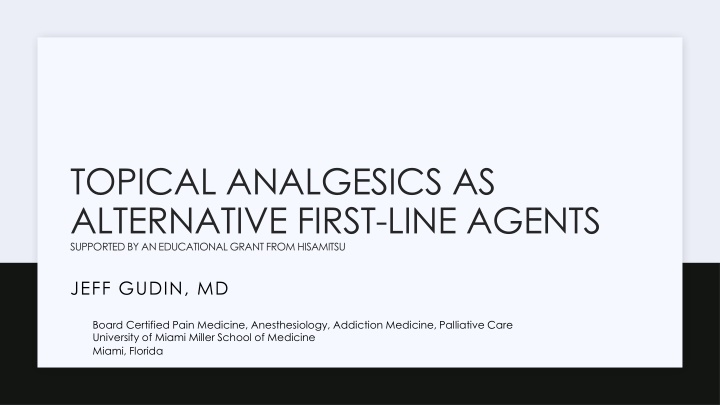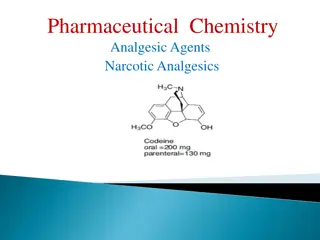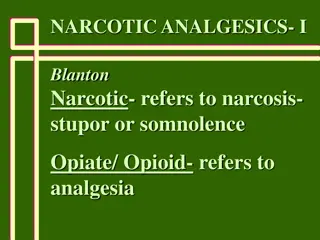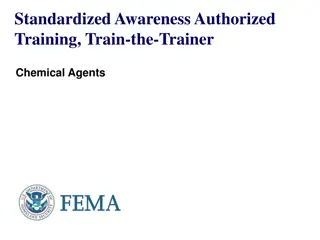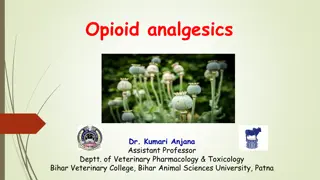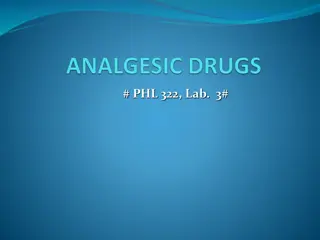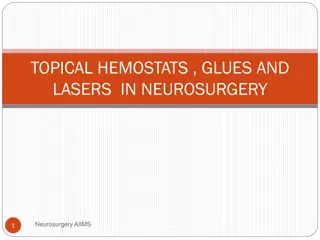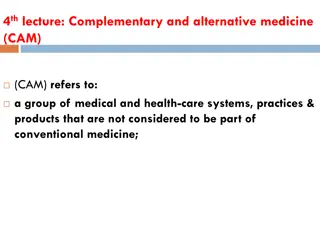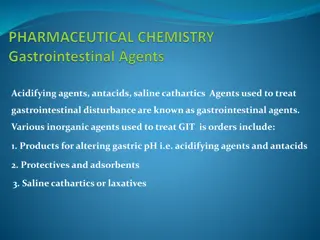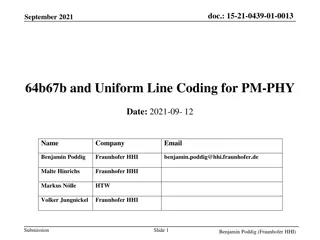Topical Analgesics as Alternative First-Line Agents
Topical analgesics are increasingly used as first-line agents for pain management. They offer benefits such as avoiding GI-related issues, opioid sparing, and minimizing systemic side effects. Understanding the anatomic targets, active ingredients suited for topical delivery, and various formulations is essential. Consultation with a pain specialist can help navigate the potential adverse reactions of different topical preparations.
Download Presentation

Please find below an Image/Link to download the presentation.
The content on the website is provided AS IS for your information and personal use only. It may not be sold, licensed, or shared on other websites without obtaining consent from the author.If you encounter any issues during the download, it is possible that the publisher has removed the file from their server.
You are allowed to download the files provided on this website for personal or commercial use, subject to the condition that they are used lawfully. All files are the property of their respective owners.
The content on the website is provided AS IS for your information and personal use only. It may not be sold, licensed, or shared on other websites without obtaining consent from the author.
E N D
Presentation Transcript
TOPICAL ANALGESICS AS ALTERNATIVE FIRST-LINE AGENTS SUPPORTED BY AN EDUCATIONAL GRANT FROM HISAMITSU JEFF GUDIN, MD Board Certified Pain Medicine, Anesthesiology, Addiction Medicine, Palliative Care University of Miami Miller School of Medicine Miami, Florida
Consulting Fee (e.g., Advisory Board): Hisamitsu, Sanofi, Glaxo, Quest Diagnostics Stock Option Holder (Individual stocks/ Stock options; diversified mutual funds do not need to be disclosed): Virpax, Versea DISCLOSURES
Identify anatomic targets for topical medications Evaluate active ingredients well suited for topical delivery Differentiate various formulations of topically applied medication Discuss the potential adverse reactions of various topical preparation LEARNING OBJECTIVES
The main mechanism of SYSTEMIC ANALGESICS action of these agents is to act at specific sites located in both the central nervous system and the periphery
SYSTEMIC ANALGESIC AES APAP AND NSAIDS MU OPIOIDS ADJUVANTS Bothersome Bowel, Bladder Pruritis, Sweating Somnolence TCAs, SSRIs Gabapentinoids Muscle Relaxants Steroids Hepatic, Renal Dangerous Death CV, Renal, GI, Platelet A myriad of AE s
BENEFITS ASSOCIATED WITH TOPICAL ADMINISTRATION: + Avoids issues related to GI problems (i.e., swallowing difficulties, nausea, vomiting) + No need for absorption from the gastrointestinal (GI) tract + Eliminates the hepatic first pass effect + Tissue concentrations > systemic Minimizes plasma concentrations and associated adverse effects + Allows patients to lower consumption of oral analgesics (opioid sparing) +/- Simplicity and convenience of administration may increase compliance, quality of life.
Topical Analgesic Anatomic Targets The main mechanism of action of these agents is to act at targets mostly in the periphery http://accurateclinic.com/wp-content/uploads/2019/06/Transdermal-and-Topical-Drug-Administration-in-the-Treatment-of-Pain.pdf
RECOMMENDATIONS BY INTERNATIONAL SOCIETIES AND GUIDELINE COMMITTEES ON USE OF TOPICAL NSAIDS TO MANAGE OSTEOARTHRITIC PAIN OF THE HAND AND KNEE Recent AAFP/ACP non-low back pain Guidelines https://www.futuremedicine.com/doi/pdfplus/10.2217/pmt-2017-0047
NOT ALL DATA SUPPORTS TOPICAL ANALGESICS
Brutcher R, Kurihara C, et al. March 2019 COMPOUNDED TOPICAL PAIN CREAMS TO TREAT LOCALIZED CHRONIC PAIN: A RANDOMIZED CONTROLLED TRIAL Utilized pain creams compounded for 399 patients: neuropathic pain (n = 133) [ketamine, gabapentin, clonidine, and lidocaine], nociceptive pain (ketoprofen, baclofen, cyclobenzaprine, and lidocaine) [n=133], mixed pain (ketamine, gabapentin, diclofenac, baclofen, cyclobenzaprine, and lidocaine) [n=133], or placebo. The primary outcome measure was average pain score 1 month after treatment. A positive categorical response was a reduction in pain score of 2 or more points coupled with a score above 3 on a 5-point satisfaction scale. Secondary outcomes included Short Form-36 Health Survey scores, satisfaction, and categorical response. https://www.acpjournals.org/doi/10.7326/M18-2736
CONCLUSION: COMPOUNDED PAIN CREAMS WERE NOT BETTER THAN PLACEBO. Results: For the primary outcome, no differences were found in the mean reduction in average pain scores between the treatment and control groups At 1 month, 72 participants (36%) in the treatment groups and 54 (28%) in the control group had a positive outcome (risk difference, 8% [CI, 1% to 17%]). Limitations: Generalizability is limited by heterogeneity among pain conditions and formulations of the study interventions. Randomized follow-up was only 1 month.
Local Anesthetics NSAIDs, salicylates, steroids ACTIVE Rubefacients: Camphor, Menthol, methyl salicylate INGREDIENTS IN TOPICAL PREPARATIONS (ester wintergreen oil) Capsaicin Opioids Clonidine Ketamine Cannabinoids
TOPICAL LOCAL ANESTHETICS
LOCAL ANESTHETICS Relieve pain by reducing ectopic discharges of somatic nerves in areas of localized pain. Binds to sodium channels and suppresses abnormal painful spontaneous discharges. Are available in patches/plasters, sprays, creams, gels and in an Eutectic Mixture of Local Anesthetics (EMLA) as a cream containing 2.5% prilocaine and 2.5% lidocaine. In the United States, the lidocaine patch 5% is approved for use in patients with post-herpetic neuralgia. Newer patch formulations available with significantly lower amounts of drug. [Original patch contains 700 mg lidocaine; newer bioequivalent patches contain 36 mg] Even with multiple patch applications, the systemic levels remain low. Topical administration of this group of drugs has been shown to be safe and relatively free of major side effects. A PK study revealed >20x lower plasma conc than necessary to produce toxic effects. OTC patches available up to 4% Mostly unknown PK data; formulation and adhesion affect drug delivery!
CASTRO E, DENT D. PAIN MANAGEMENT VOL. 7, NO. 6 A COMPARISON OF TRANSDERMAL OTC LIDOCAINE 3.6% MENTHOL 1.25%, RX LIDOCAINE 5% AND PLACEBO FOR BACK PAIN AND ARTHRITIS 87 patients were randomized in a double-blind, placebo-controlled trial, to compared transdermal patches: over-the-counter (OTC) lidocaine 3.6% with menthol 1.25%, lidocaine 5% (Rx) and placebo. Results: OTC met primary end points of noninferiority compared with Rx for efficacy, side effects and quality of life. OTC proved superiority versus placebo for efficacy, general activity and normal work. Side effects were similar. Conclusion: It is theorized that menthol's ability to increase skin permeability facilitated more efficient drug delivery to the site of pain causing higher than expected efficacy. Decreased cost and resource utilization could benefit patients and payers. https://www.futuremedicine.com/doi/abs/10.2217/pmt-2017-0029
TOPICAL NSAIDS FOR CHRONIC MUSCULOSKELETAL PAIN IN ADULTS. 2016 Cochrane review included RCTs of minimum 2 weeks and up to 12 weeks duration. In all, 39 RCTs met the inclusion criteria representing 10,631 patients with OA mainly of the knee. The primary outcome measure was the clinical success rate ( 50% reduction in pain intensity). Topical NSAIDs investigated were diclofenac, eltenac, etoricoxib, felbinac, flufenamate, flurbiprofen, indomethacin, ibuprofen, ketoprofen, nimesulide, piketoprofen and piroxicam, which were formulated as solutions, gels or plasters (patches). Data sufficient to perform pooled analyses were available only for diclofenac and ketoprofen. In studies lasting 6 12 weeks, the NNT compared with carrier/other active was 9.8 (95% CI: 7.1 16) with topical diclofenac (six studies; 2343 participants; moderate quality evidence), and 6.9 (95% CI: 5.4 9.3) with topical ketoprofen (four studies; 2573 participants; moderate quality evidence), leading the authors to conclude that topical diclofenac and topical ketoprofen provide good levels of pain relief in knee osteoarthritis in people aged over 40 years . Derry S, Conaghan P, Da Silva JA, Wiffen PJ, Moore RA. Cochrane Database Syst. Rev. 4, CD007400 (2016). Cochrane review of randomized controlled trials concludes that topical diclofenac and topical ketoprofen provide good levels of pain relief for osteoarthritis.
TOPICAL NSAIDS NSAID s are the most commonly used topical agents in clinical practice. Produce high concentration in the dermis, synovium, muscle tissue, and joint cartilage, yet its bioavailability is low, ranging from 5% to 15% of that observed after systemic administration Formulations that facilitate tissue penetration may improve efficiency in deeper sites, such as joints. https://www.painweek.org/media/journal/everybodys-greasing-should-you-rub-it
Clinical Guidelines, August 2020 NONPHARMACOLOGIC AND PHARMACOLOGIC MANAGEMENT OF ACUTE PAIN FROM NON LOW BACK, MUSCULOSKELETAL INJURIES IN ADULTS: A CLINICAL GUIDELINE FROM THE AMERICAN COLLEGE OF PHYSICIANS AND AMERICAN ACADEMY OF FAMILY PHYSICIANS Guideline is based on a systematic evidence review on the comparative efficacy and safety of nonpharmacologic and pharmacologic management of acute pain from non low back, musculoskeletal injuries in outpatient adults Evaluated the following clinical outcomes using the GRADE (Grading of Recommendations Assessment, Development and Evaluation) system: pain (at 2 hours and at 1 to 7 days), physical function, symptom relief, treatment satisfaction, and adverse events. ACP and AAFP recommend that clinicians treat patients with acute pain from non low back, musculoskeletal injuries with topical nonsteroidal anti-inflammatory drugs (NSAIDs) with or without menthol gel as first-line therapy (Grade: strong recommendation; moderate-certainty evidence). https://www.acpjournals.org/doi/10.7326/M19-3602?_ga=2.133804174.1453619572.1599069617-22408473.1599069617
TOPICAL RUBIFACIENTS RUBEFACIENTS WORK BY COUNTER IRRITATION, CAUSING VASODILATION AND INCREASED BLOOD FLOW, WHICH CONTRIBUTES TO THE WARMING SENSATION MANY PEOPLE FIND APPEALING
Derry S, Matthews P, et al. 2014 TOPICAL RUBEFACIENTS FOR ACUTE AND CHRONIC MUSCULOSKELETAL PAIN IN ADULTS Although the authors concluded that the evidence did not support the use of topical rubefacients, they noted the amount and quality of the available data led to uncertainty about the effects These agents seemed to be relatively well tolerated in the short- term, based on limited data.
Higashi Y, Kiuchi T, et al. Vol. 32, Issue 1, January 2010. p3443 EFFICACY AND SAFETY PROFILE OF A TOPICAL METHYL SALICYLATE AND MENTHOL PATCH IN ADULT PATIENTS WITH MILD TO MODERATE MUSCLE STRAIN A randomized, double-blind, parallel-group, placebo-controlled, multicenter study to determine the efficacy and safety profile of a patch containing 10% methyl salicylate and 3% l-menthol compared with a placebo patch 208 patients were randomly assigned to receive either 1 active patch or 1 placebo patch applied to the skin at the affected area (ie, shoulder, upper back, upper arm, neck, calf, thigh, forearm, abdomen). Pain intensity was assessed on while at rest and with movement for 12 hours after patch application. The primary efficacy end point was the summed pain intensity difference score through 8 hours (SPID8) with movement. Safety data, including adverse events, and secondary efficacy end points were also evaluated.
HIGASHI, ET AL Patients receiving the active patch experienced significantly greater pain relief (~40%) than those patients receiving a placebo patch (mean [SD], 182.6 [131.2] vs 130.1 [144.1]; P = 0.005). The number of patients experiencing any type of adverse event was comparable between study groups (active patch, 6.7% [7 events]; placebo patch, 5.8% [6 events]). No serious adverse events were reported during the study. Conclusion: A single, 8-hour application of a patch containing methyl salicylate and l-menthol provided significant relief of pain associated with mild to moderate muscle strain in these adult patients compared with patients receiving a placebo patch. This study was used as the basis for a NDA and FDA approval of an OTC pain patch
Journal of Pain Research Gudin J, Dietze D, Hurwitz P. 2020 Volume 13 IMPROVEMENT OF PAIN AND FUNCTION AFTER USE OF A TOPICAL PAIN-RELIEVING PATCH: RESULTS OF THE RELIEF STUDY Evaluated a topical analgesic pain-relieving patch in reducing BPI pain severity and improving function in patients with mild to moderate arthritic, neurological, or musculoskeletal pain. The treatment group (n=152) received patches for 14 days. A control group (n=47) did not receive the patch. After day 14, 34 control patients crossed over to treatment with the patch. Surveys were administered to patients at baseline and 14 days to assess changes in pain severity and interference. Changes in oral pain medication use, side effects, and satisfaction use were also assessed. At day 14, TG pain severity score and pain interference score decreased (49% and 58.1%, respectively). Pain severity and interference scores decreased less in the CG (12.3% and 14.8%, respectively). In the study, 60.5% of the TG were using concomitant oral pain medications a lot less , and 90.8% were very/extremely satisfied with the patch. https://www.dovepress.com/improvement-of-pain-and-function-after-use-of-a-topical-pain-relieving-peer-reviewed-article-JPR
Capsaicin is a highly selective agonist for the transient receptor potential channel vanilloid-receptor type 1 (TRPV1), which is expressed on central and peripheral terminals of primary sensory neurons. Capsaicin of various purities and grades has been widely available in pharmacies as low-to- moderate concentration creams and gels. Increased local perfusion and the resulting warming or capsaicin-induced pain leading to counterirritation were initially thought to account for the analgesic effects of capsaicin. Knockout studies have revealed the importance of TRPV1 as a molecular pain integrator and target for novel analgesic agents. Topical application of capsaicin at the peripheral terminal of TRPV1-expressing neurons superficially denervates the epidermis in humans in a highly selective manner and results in hypoalgesia. In recent randomized controlled trials, a patch containing high-concentration capsaicin demonstrated meaningful efficacy and tolerability relative to a low-concentration capsaicin control patch in patients with peripheral neuropathic pain.
Intraepidermal nerve fibers retract following high-dose topical capsaicin treatment. Reprinted from Kennedy WR, Vanhove GF, Lu SP, Tobias J, Bley KR, Walk D, Wendelschafer-Crabb G, Simone DA, Selim MM: A randomized, controlled, open-label study of the long-term effects of NGX-4010, a high-concentration capsaicin patch, on epidermal nerve fiber density and sensory function in healthy volunteers. J Pain 2010;11:579 587.
8% CAPSAICIN PATCH IN ADDITION TO PHN, IN JULY 2020 U.S. FDA APPROVED FOR THE TREATMENT OF NEUROPATHIC PAIN ASSOCIATED WITH DIABETIC PERIPHERAL NEUROPATHY OF THE FEET
TOPICAL OPIOIDS Opioid receptors have been found on peripheral nerves and inflamed tissue Morphine and its metabolites are largely undetectable systemically when applied topically to skin ulcers (suggesting the analgesic effect is local) Peripheral opioid injections for local analgesia, such as intra-articular morphine have been found to be effective in several trials. Of note, animal studies suggest that opioids can accelerate wound healing by up-regulating nitric- oxide synthase. The relevance of this for humans is unknown and there is no consensus regarding whether topical opioids benefit or impede wound healing in humans.
Tennant F. April 2010 TAKING ADVANTAGE OF THE PERIPHERAL OPIOID RECEPTOR Not all opioids provide topical pain relief. The opioids most commonly prescribed by the author: morphine, hydromorphone and oxycodone. Each relatively insoluble and act directly on opioid receptors without requiring further metabolism Although not officially classified as an opioid, carisoprodol produces considerable analgesia when topically applied. Some patients use methadone topically and find it effective. There are some opioids that are inert on the skin surface. Hydrocodone, codeine, and tramadol are pro-drugs which require liver metabolism to convert them to active compounds. Fentanyl is extremely soluble and dissolves quickly through the skin making it a very effective systemic, but poor topical opioid.
TOPICAL CLONIDINE, KETAMINE, CANNABINOIDS, TCAS, GABAPENTINOIDS, OTHERS
https://www.pharmacytimes.com/publications/issue/2019/September2019/topical-analgesics-provide-pain-reliefhttps://www.pharmacytimes.com/publications/issue/2019/September2019/topical-analgesics-provide-pain-relief
SUMMARY Data support the utility of topical analgesics Like all other therapies, effectiveness may be limited to certain patients or conditions (musculoskeletal, arthritic, inflammatory, neuropathic) Maximizing opioid sparing and minimizing adverse effects versus systemic analgesics is clearly of benefit OTC products can receive FDA approval via the NDA pathway if data supports Practice Guidelines support the first line use of topical analgesics
Thank you Jeff Gudin, MD Questions?
